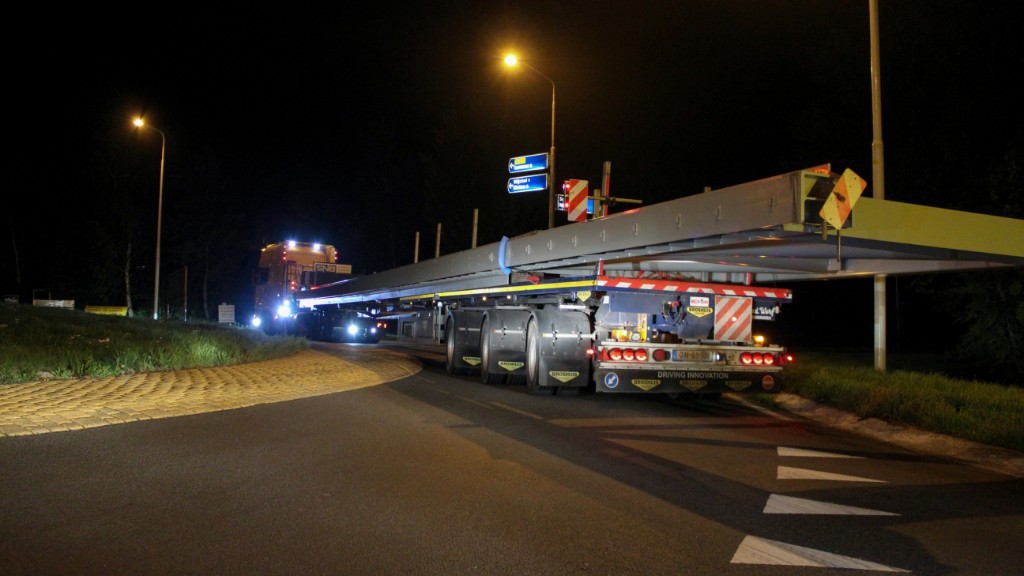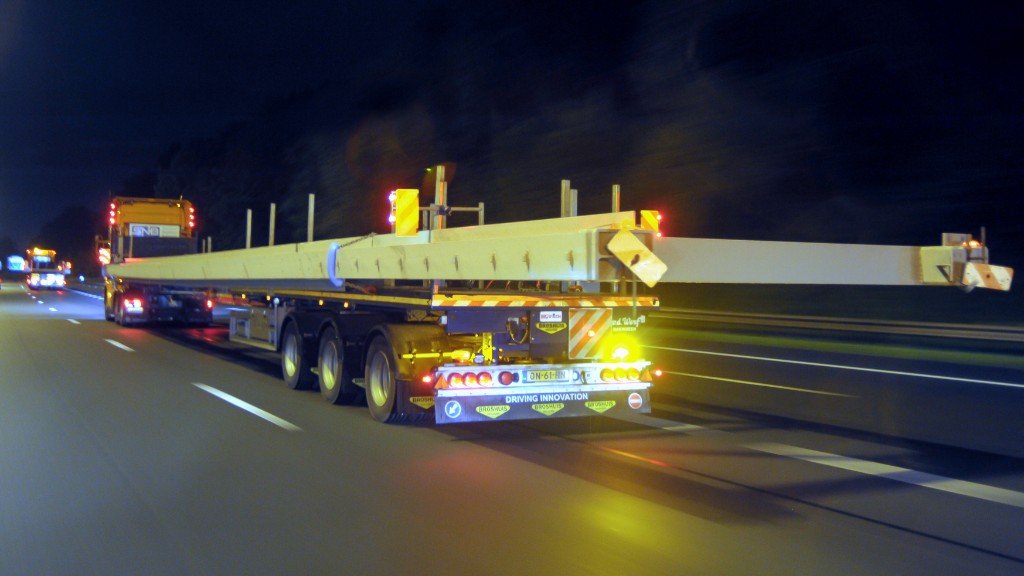Ask us
your question!
The Client
The men of Van der Werf Transport, in Bakhuizen in the Province of Friesland, don't worry about a metre more or less, as Van der Werf often transports steel structures for its neighbour, Nagelhout Staalbouw. Tonight's load is also from Nagelhout, two enormous steel structures for a construction project in Breda.
We arrive in Bakhuizen at around midnight. Bakhuizen is in the southwest of the Province of Friesland, on the beautiful banks of the IJsselmeer. During the day, the gently rolling landscape in this part of Friesland is sometimes resemblant of Denmark, although there's little to see of all that at the moment. We drive through the wisps of mist towards the village, which is deep in sleep. Only the lights at Nagelhout – or, to be more precise, at the neighbours – are still burning. That's not at the neighbouring Van der Werf transport company, but at another neighbour. This is because the Bakhuizen grit blasting and coating company, which is located on the same industrial park, also works for Nagelhout Staalbouw. That's how things work here: one company manufactures steel structures, another conserves them and yet another transports them. This makes sure that the village maintains its level of employment – and these companies certainly appear to be making a great contribution, as Johan van der Werf says that there is usually a lot of work going on in the steel business.
The challenge
Johan is one of Van der Werf Transport's three partners. Johann, together with his brother, Frans B. van der Werf, and nephew Frans J. van der Werf, runs the transport company that operates four tractor units. “We have a whole series of trailers for our four Scania tractor units, so we can hitch and unhitch as required. That works very well.” After a cup of coffee, Johan begins loading the enormous steel structure. The double extended Broshuis semi trailer is in the hall, where loading is very easy. Johan attaches the lifting strops to the structure and uses four heavy overhead cranes to lift the monster. The steel structure, with a length of 30 metres and a width of four metres, glides gently through the hall until it is above the semi trailer. Johan uses the wireless remote control to manoeuvre the twenty-tonne structure into the correct position, all with the greatest of ease. The monster is slowly lowered onto a couple of large wooden blocks on the semi trailer.
The solution
Once the load has been secured with chains, Johan fits the overwidth signs and flashing lights. The accompaniment has now also arrived. “We'll be using two combinations. Frans's combination is already loaded. It's a bit shorter but just as wide, which is why we're doing it like this. We now need only two accompanying vehicles until Breda. A third one will join us just before our destination to get us through the city.” Johan is by now thoroughly familiar with the route. “I travelled this same route yesterday, with a slightly shorter section. That means I know exactly where the problems can arise when things get difficult, although I don't expect any difficulties. However, we can get into difficulty when a car is parked wrongly or when, for example, a higher vehicle is parked along the road. The load passes over cars, but we can have problems with a van.”
Once everything is ready for departure, the double extended semi trailer is skilfully driven outside. The manual steering ensures that the long load can be driven out of the hall in one smooth movement. The unit then reverses to the public road, where the nose is pointed in the right direction. It's now about two-thirty, and apparently that's coffee time in the special transport sector. We go to the canteen, where dozens of photos recall Van der Werf Transport's history. The company began as a sand and gravel business with small tipping trailers, but that's all in the past. “We stopped using small tipping trailers years ago. Now we only do that sort of work with open semi trailers. In addition to our extendible semi trailers, we also have semi low loaders and a boat trailer. Those really are special transports, and we've at really is a specialism, and we've cornered them’’ Johan says.
When we have finished our coffee we get into the cabins. The wisps of mist are lit intermittently by the many orange flashing lights when the convoy slowly begins to move. The men know the narrow roads between the trees like the back of their hands, and even though the load is very large the combinations rapidly pick up speed. Travelling at night offers the major benefit of the absence of approaching traffic. That makes things much easier! We drive on the back roads to Lemmer, where we join the motorway. The R520, with its V8, has no trouble with the weight, although the dimensions give cause to great care. Nevertheless, the drivers have no qualms about getting a move on.
The benefits
Most of Van der Werf's semi trailers are from Broshuis: the new, double extendible three-axle semi trailer carrying the longest section also comes from Kampen. Johan says “We've enjoyed working with Broshuis for many years. They make precisely what we need and they stand behind their products. That's important, because we must have blind trust in their trailers.” The semi trailer follows the tractor unit neatly, and when we reach the back roads on the last section of the route everything depends on the steering. In some places, the gap is just wide enough for the load: on occasion, the steel structure almost brushes the trees and lampposts. The three axles observe the commands from the remote control and the destination is reached without problems. Taking the very last corner, onto the construction site, is a little tense. This is a typical point where a high goods vehicle would cause problems. However, the low cars parked along the road do not obstruct the high load. The load has arrived safely and without a scratch. Now it's all up to the crane driver and the construction team who will work on the span. For the Van der Werf men, the job is done.


